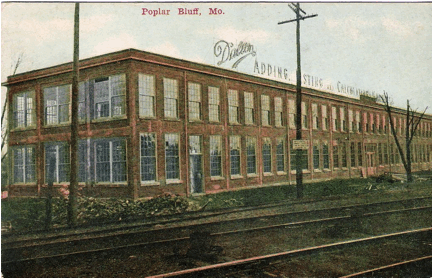Dalton's place in History of adding machines.
The Standard Adding Machine Company, founded by mr. W. H. Hopkins and the Dalton Adding Machine Company, played an important role in mechanical adding machine history. They have both made in 1902 the first 10 key machines based on the design of mr. William Hubert Hopkins patented by him and partly by James L. Dalton (situation can be debated).
This clever mechanism, overruled the full keyboards and made the needed table desktop space much more economical, the error rate smaller and calculating speed faster.
For details I like to refere to the chapter "How do they calculate", sub menu "Rocking Segment" and "Ten Key".
The key-board layout, from a Standard Adding and a Dalton machine, differs. The first has one line of ten keys the Dalton has two lines, on the top line: 2, 4, 5, 7, 9 and the bottom line: 1, 3, 0, 6, 8. The same keyboard layout is used at the Swedish Facit pinwheel calculators.

The history of the Dalton Adding Machine Company
James Lewis Dalton, sometimes known as the inventor, but also known as the patentee and marketer of the adding machine. His first little factory was built in Poplar Bluffs, Missouri. The "company" was formed in St. Louis in August, 1903, by James L. Dalton as the Adding Typewriter Company.
The first ten key adding machine went on to become one of the most important and popular 10 key adders of his time. Until 1906 six machines were built. By the 1920's over 150 different models had been designed.
The patent for the adding machine is dated 11 April 1904 and deposition to James L. Dalton, 20 Apr. 1904, Patent Applications, National Archives, College Park, Maryland. There is conflicting information on who invented the machine, but there is certainty that James Lewis patented the machine and marketed it and successive models internationally. He apparently was the investor/manufacturer/marketer of the adding machine and not the inventor, that was mr. William Hubert Hopkins. From january 1907 the volume production started, the business grew to a $10,000,000 operation. The older machines have a wide carriage or sliding carriage.
In 1914 the Dalton Adding Machine Company moves from Poplar Creek, Missouri to Norwood—at 4923 Beech Avenue between Norwood Avenue and Highland Avenue (later, the location of The Day Company and currently Rumpke). The company was bought out by Remington Rand in 1926.
This chapter is extracted from http://www.daltondatabank.org/Chronicles/James_L_Dalton-Adding_Machine.htm
Strange enough I didn't came across any Dalton type numbering system. Does someone has this ? Please e-mail me !

A picture from an office which uses the early dalton machines. (Picture form the Office museum)